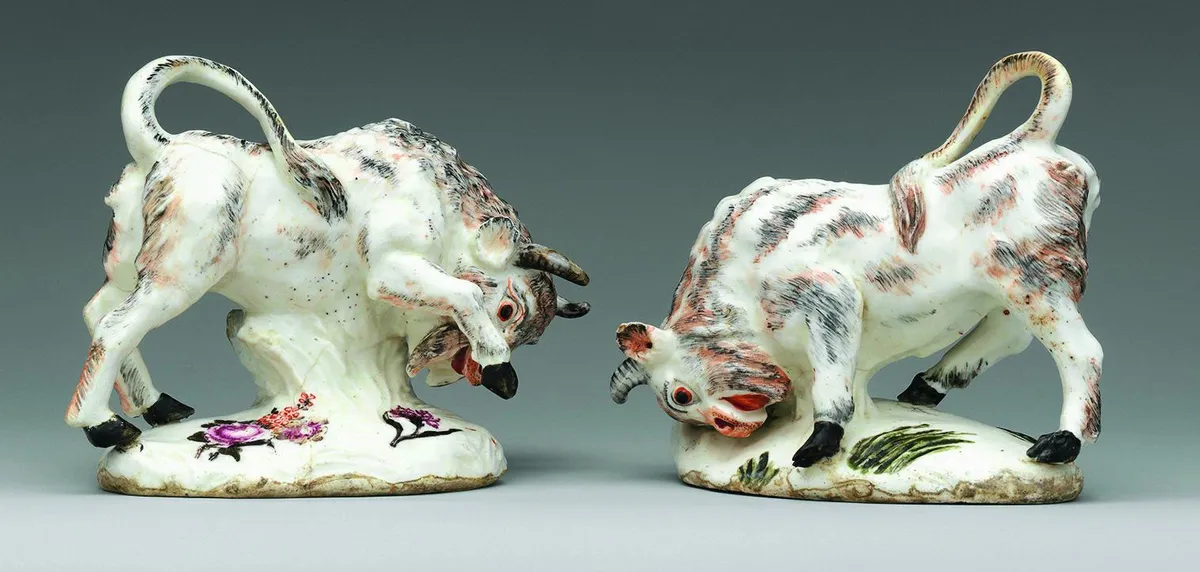The beautiful city of Derby houses the only surviving British porcelain factory that still produces all its porcelain on its own premises – others have either closed long ago or moved their operations abroad. It all started very small at Derby: in 1748, a son of French Huguenot immigrants called Andrew Planché made his meagre living by firing little porcelain animals in a homebuilt kiln in his back yard.
How he knew about porcelain is a mystery; some say he or his father learned the skill in Meissen; others point out that he had grown up in a closeknit community of Huguenots with knowledge of porcelain, among whom were Nicholas Sprimont, founder of the Chelsea factory, Nicholas Crisp, founder of the Vauxhall factory, and Charles Gouyn, who had a factory at St James.
Whatever the truth of this, Planché had a talent for creating little toy figures; a steady stream of cats, dogs and sheep left his kiln to delight the people of Derby. By then he had teamed up with brilliant porcelain decorator William Duesbury and local banker John Heath to start a brand new factory.

Planché quickly disappeared from the scene (possibly something to do with an entry of an illegitimate son in the local church register) and Heath was bankrupted, leaving Duesbury to shape the new factory alone.
Duesbury was a man of many talents. An accomplished porcelain artist with a knowledge of both the process and the artistic demands of porcelain manufacture, he also had a keen eye for business and the growing competition. Duesbury ran a tight ship; his workers signed documents to protect company secrets, and the quality and cost of their work was monitored.
Some cringeworthy notices survive, stating workers’ names and potential fines if they were found wandering from their workstations. But Duesbury’s business acumen resulted in a strong factory that was constantly able to increase and improve production.
Derby produced many different items in this early ‘Golden’ period, but the figures are what we are most familiar with today. That doesn’t mean tableware was not produced but, as the porcelain body was not sufficiently resistant to hot water, much of it did not survive: historical archives contain customers’ letters complaining about their burst teapots!

Unlike the tableware, the Derby figures wholly deserve their fame. In the early years you can see Planché’s extraordinary talent; each figure has a unique sense of motion, seemingly swirling around and lifting its feet off the ground.
In later years, Duesbury was able to steadily improve the porcelain body and decoration, designing hundreds of different figure shapes: mythical Roman gods, amorous shepherds and shepherdesses, famous contemporary actors (yes, they had celebrity culture in the 18th century!), and, of course, animals. Today, Derby figures can still be found everywhere in the world in museums, homes and auction houses.
As porcelain became all the rage, stiff competition emerged: as well as imports from China, Germany and France, and the London factories at Chelsea, Bow and Vauxhall, there was an emerging factory in Worcester, and powerful decorating studios like James Giles (another son of Huguenots) in Kentish Town in London.
However, many of these enterprises suffered from an over-reliance on the skill of a talented individual – both Chelsea and Bow were unable to survive beyond the genius of their founders. James Giles lacked financial acumen and the Vauxhall factory suffered financial misfortune.
Duesbury at Derby chose a different path; he reckoned that competition could be turned into opportunity. Between 1764 and 1776, every time a competitor failed, he bought them up. Sometimes this was to make them harmless by closing them down, at other times it was to extend his own business by adding their workers, skills and moulds to his own operations.
Chelsea in particular provided talented workers, an improved porcelain recipe and brighter enamels. Bow added moulds and further knowledge of the use of bone ash, which strengthened the previously fragile recipe (remember the teapots).
By the end of his life in 1786, Duesbury oversaw a factory that employed countless top artists, capable of producing vast quantities of high-quality wares. Without Chelsea and Bow, in particular, Derby might not have been so successful as to still survive today; but, equally, through Duesbury’s appetite for cannibalising his competitors, many of their skills, designs and innovations were allowed to live on in the exciting period that would follow.
